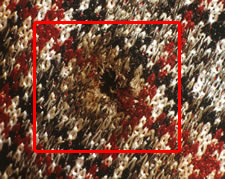Home | Glossary | Resources | Help | Contact Us | Course Map
Archival Notice
This is an archive page that is no longer being updated. It may contain outdated information and links may no longer function as originally intended.
Reproduction of Results
To reproduce results, the suspect firearm must be available. The size and density of residue patterns vary based on a combination of factors that may include the firearm, ammunition, barrel length, caliber, powder type, and powder charge. When residue patterns are reproduced in a shooting case, it is essential that the firearm and ammunition used in known-distance testing be as similar as possible to that used in the case.
Sources of testing ammunition may include
- evidence ammunition from the case, per laboratory protocol,
- purchased ammunition (same brand, stock number, with the same powder, projectile and primer components),
- reference ammunition (same brand, stock number, with the same powder, projectile, and primer components).
Note: Examiners should always be aware that reference collections/database programs are seldom all inclusive; all available resources and examiners should be consulted.
Selection of test target media is also an important factor. For the majority of cases, chemically uncontaminated white twill jean cloth is suitable to approximate the characteristics of a variety of fabric types.
However, there are instances in which the physical characteristics of the fabric of a victims garment preclude the reproduction of a meaningful test pattern. For example, artificial fibers, leather or plastic, or an open weave or fuzzy texture may require that fabric be purchased to duplicate the evidence material. It may be obtained at a fabric store, or a portion of the evidence may be used, based on laboratory protocol.
If the questioned surface is drywall, paneling, upholstery, etc., the same alternative sources apply.
Nitrite Residue Patterns
When reproducing patterns of nitrite residues, known-distance targets should be fired to produce patterns both smaller and larger than the evidence residue patterns. It is then possible to establish a range of distances for the evidence nitrite pattern. This range is generally at least a foot wide to account for possible variations in the ammunition type or resulting from evidence handling prior to receipt in the laboratory. Note that if a range is expressed as a conclusion, that the statement must include substantiated test fired patterns at each end of the range.
Scattered Nitrite Residues or Vaporous Lead
When reproducing results using these types of residue, the best distance determination is the maximum distance to which those residues can be projected, barring the presence of an intermediate object. The testing procedure is to produce data from two distances, one at which the particular residue is always found and the distance at which the residue is never found. This approach establishes a range that determines maximum distance.
The minimum distance is established based upon the results of the examination of evidence. At least three test shots are fired at each known distance. This will account for variations that may be present.
| Distance Determination Using Nitrite/Lead Residue Test | |||
| Distance (Feet) | Test 1 | Test 2 | Test 3 |
| 5 | present | present | present |
| 6 | present | not present | present |
| 7 | not present | not present | not present |
Based upon the results in the above table, a range of five to seven feet is established as the maximum distance to which this particular type of residue is projected.
Additional Online Courses
- What Every First Responding Officer Should Know About DNA Evidence
- Collecting DNA Evidence at Property Crime Scenes
- DNA – A Prosecutor’s Practice Notebook
- Crime Scene and DNA Basics
- Laboratory Safety Programs
- DNA Amplification
- Population Genetics and Statistics
- Non-STR DNA Markers: SNPs, Y-STRs, LCN and mtDNA
- Firearms Examiner Training
- Forensic DNA Education for Law Enforcement Decisionmakers
- What Every Investigator and Evidence Technician Should Know About DNA Evidence
- Principles of Forensic DNA for Officers of the Court
- Law 101: Legal Guide for the Forensic Expert
- Laboratory Orientation and Testing of Body Fluids and Tissues
- DNA Extraction and Quantitation
- STR Data Analysis and Interpretation
- Communication Skills, Report Writing, and Courtroom Testimony
- Español for Law Enforcement
- Amplified DNA Product Separation for Forensic Analysts


